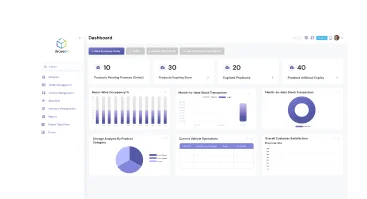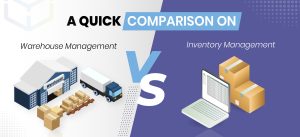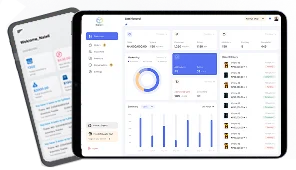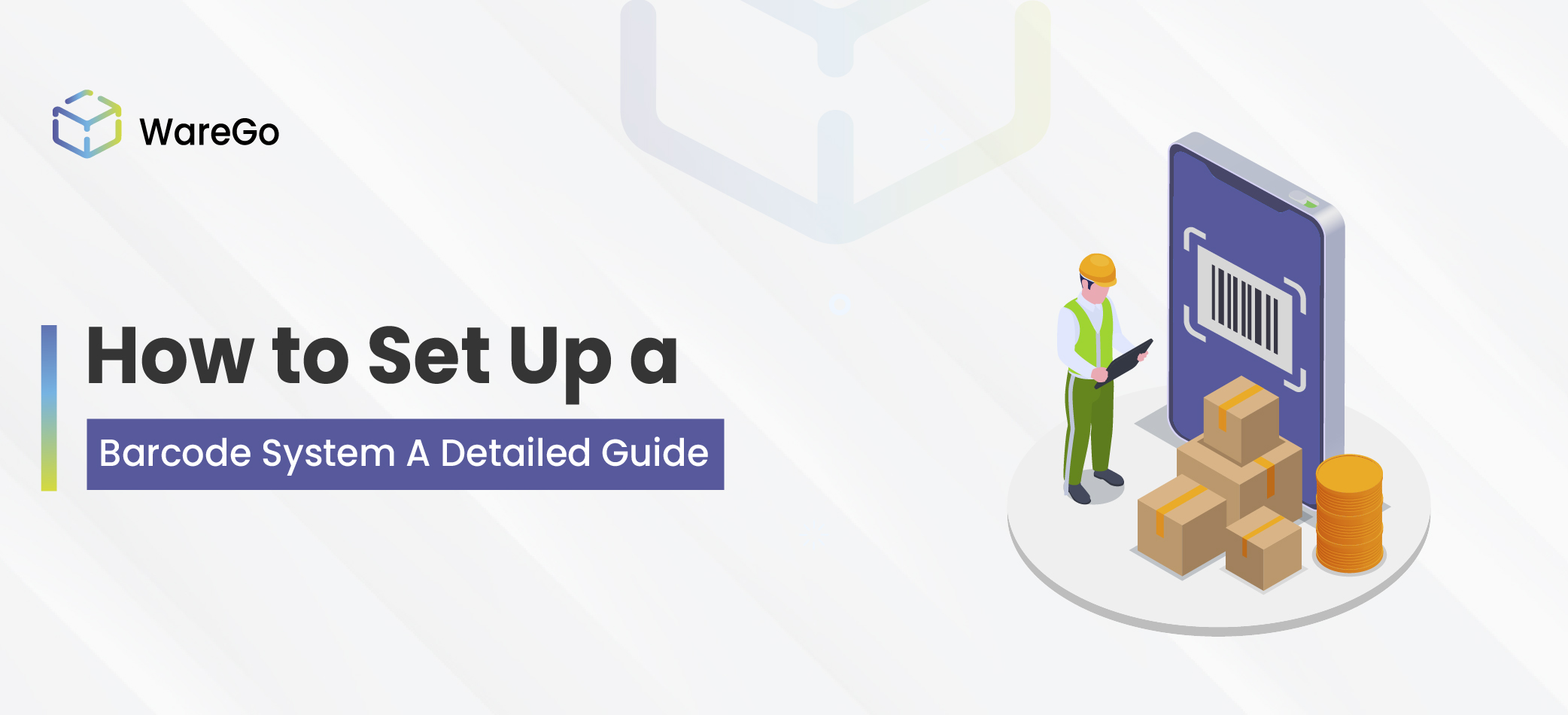
In today’s world, barcodes are among the most versatile, affordable, and easy-to-use tools that every business owner is looking forward to.
Barcode scanning systems mean scanning a product to view data on stock levels, consider their product costs, and create an accurate inventory record system.
Not all warehouse management software excels at barcode scanning; consider CAT-EYE before selecting the one that best suits your needs.
According to the research, the size of the barcode systems market is estimated to reach USD 13.60 billion by 2030, up from USD 8.14 billion in 2023.
Isn’t this all good news? Indeed, it is, but the main question here comes in how to set up a barcode system for your business.
In this blog, we will discuss how to set up a barcode system, how it works, and which tools and software to use for creating and tracking these systems.
WareGo can help you walk through the best barcode system for your business
Book us now!Table of Contents
What are Barcode Systems and How They Work
Barcodes refer to black and white lines with machine-readable codes that are converted into electronic impulses.
In simple terms, the barcode system is a software used to automate data collection by reading and scanning codes, such as lines, spaces, and labels.
Initially, barcodes were invented to track inventories in grocery stores, making it convenient to keep a record of all the stock on hand. However, by 2025, barcodes will be used everywhere, from various industries to livestock, and will have become a necessity.
How Barcodes Work?
Barcodes are read by a scanner that converts the labels’ electrical impulses into data. The scanner then forwards the impulses to a computer, which translates those lines into processed data. This way, all target tracking gets faster and more accurate.
Together, barcodes, scanners, and barcode printers create the backbone of all warehouse scanning systems used by e-commerce retailers, warehouses, and various businesses.
Let’s dig into how the barcode system really works and how it helps business owners grow efficiently.
Tracking Inventory
Barcode scanning enables the quick and accurate tracking of inventories and products. For instance, where the inventory is located or how much stock is left in the warehouse, etc.
Throughout the product lifecycle, barcodes are scanned multiple times, such as when the product is received, stored, and sold to another party. This helps keep tabs on the product pipeline.
Customer Engagement Programs
Barcodes are becoming the most powerful tools for customer engagement and loyalty programs.
Barcodes help to track customer purchases and award points accordingly. For instance, brands can issue loyalty cards or gift cards with a barcode integrated into them that customers can scan each time they make a purchase.
Personalized Marketing Campaigns
Barcodes can help marketers to create various marketing strategies, such as discount codes and small free coupons, to attract customers.
This strategy can help businesses optimize their growth by offering a top-tier customer experience.
Personalize your strategies with WareGo for a seamless experience.
Book us now!Exactly When You Should Implement a Barcode System
There are no restrictions or a strict pattern for when a business owner should create barcodes for inventory. However, there are a few key points to consider.
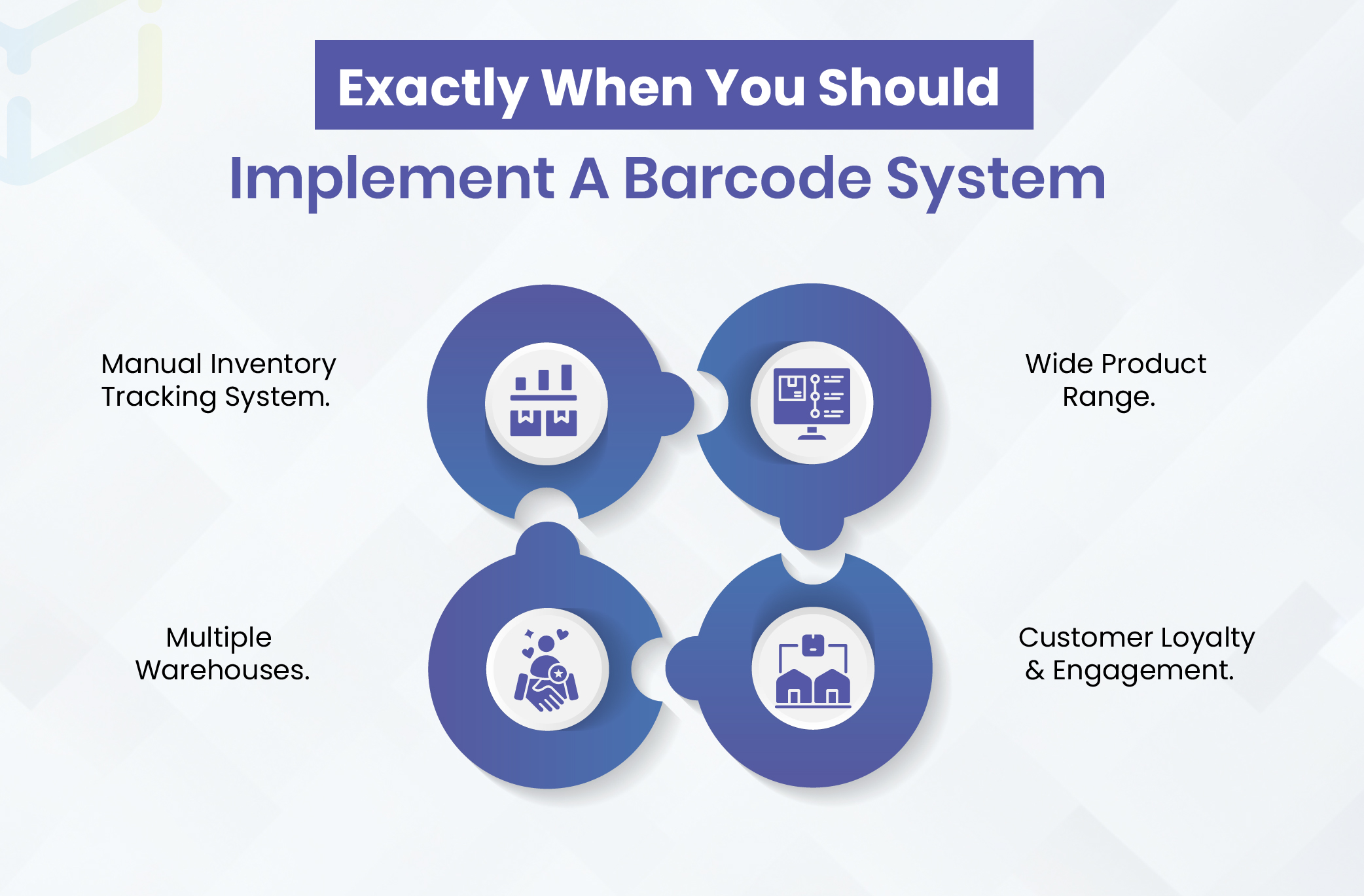
Starting with:
Manual Inventory Tracking System
If your sales are increasing but your inventory recording methods are outdated, and you’re still using pen-and-paper logs, then you need to update your methods.
There is a high risk of mistakes and blunders, and it’s time to switch to barcode database systems.
Wide Product Range
If your inventory and product range are increasing daily, it will be challenging to keep track of everything.
Barcodes here can help you record everything quickly with improved order accuracy and fulfillment.
Multiple Warehouses
Managing stocks within multiple warehouses can be difficult and creates real-time data confusion,
Barcode systems can help you maintain records across multiple locations separately, eliminating confusion and ensuring accuracy.
Customer Loyalty & Engagement
Barcodes help track customers who participate in the loyalty program and return for repeat purchases.
How to Set up a Barcode System for the Warehouse
Now that we understand the basics and the optimal time to implement a barcode system in your business, it’s time to examine the details of what to look for when setting up a barcode system. Before we begin, please note that setting up a basic scanner-based barcode system will cost between $200 and $ 1,500.
Let’s begin with a detailed overview of setting up a barcode system for the warehouse.
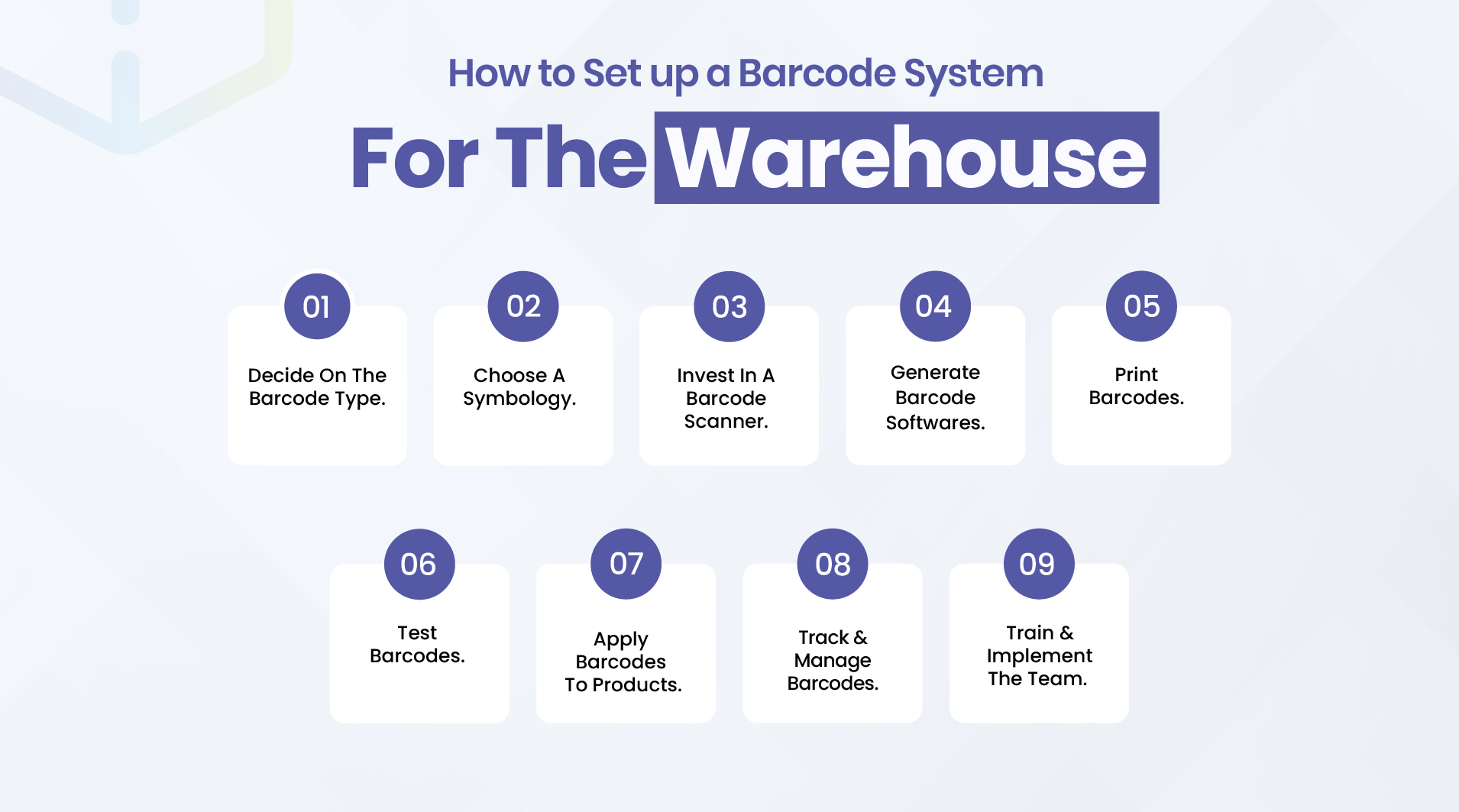
1. Decide on the Barcode Type
Selecting the right barcode type is crucial for making an informed decision. There are two main types of barcode categories you need to understand: 1D barcodes and 2D barcodes. Let’s examine their key features for a better understanding:
Main Features Of 1D Barcodes (Linear)
- The most common and used barcode type
- Tracks inventory in retail stores
- Stores a maximum of 20 digits of information
Main Features Of 2D Barcodes
- 7000+ characters can be stored at once
- Gain popularity in healthcare and logistics
After reading the key features, it will be easier for you to choose which one of them to use for your initial implementation.
2. Choose a Symbology
After the type, the next step is to choose which symbology suits your business. Symbology refers to a specific format for encoding data in a barcode.
Some popular symbologies are Code 128, Code 39, and UPC-A. Let’s see their key features:
Key Features of Symbological Codes
- Code 128 is the most versatile, which can be used to encode any type of data.
- Code 39 is based on alphanumeric data used to track inventory
- UPC-A is the most widely used symbol for monitoring products in retail stores
3. Invest in a Barcode Scanner.
After choosing the desired symbology, you will need a barcode scanner to read those codes. All barcode scanners for inventory are categorized into two types: handheld and fixed-mount models.
These two categories have some features; let’s discuss them:
Key Features of Handheld
- The most common type of scanner
- They are small, portable, and easy to use
- Scan one bar code at a time
Key Features of Fixed-mount
- Larger and expensive than handheld
- Scans multiple products together
- Ideal for retail environments
4. Generate Barcode Softwares
Once you have confirmed that we have a barcode scanner, you must generate the barcodes to streamline operations. For that, there are many types of softwares you can opt for.
Key Features of Generated Barcodes
- Some software creates barcodes for free, while others charge a monthly subscription fee.
- Dedicated barcode generators create customization and bulk quantity creation.
- Some software options include Barcode Maker and TEC-IT, which are the most effective.
5. Print Barcodes
After generating barcodes, it’s essential to print them. You can print barcode label printer, tags, or cards. However, a large number of barcodes require thermal transfer printers; manual printers will not work.
Key Features to Print Barcodes
- Barcode printers specifically for barcode printers
- They print barcodes directly onto products
- Thermal transfer printers are faster and reliable for large retail stores
6. Test Barcodes
After the printing part, it’s necessary to test them to ensure that the system is working correctly. The most accurate way to verify this is to scan the barcodes using your barcode scanners.
Key Features Of Testing Barcodes
- Tells you if the data encoded is accurate
- Re-checking helps in reading specific symbologies that might cause trouble later.
7. Apply Barcodes to Products.
Now that all the main decisions have been made and everything is in place, it’s time to apply barcodes to your products. It can be in many forms, such as labels, tags, gift cards, or passes.
How to Apply Barcodes?
- Labels are the most common and widely used method for labeling products
- Tags are similar to labels, but they work best in larger and more durable spaces
- Cards are the least used method, but they can sometimes provide a significant advantage in customer engagement
8. Track and Manage Barcodes
Now that we have applied barcodes, it’s time to keep track of them as well. It can be done in both ways, either manually or with an inventory management software.
Key Features of Tracking
- Records real-time data with accuracy
- Helps to overstock or understock
A strong inventory management system can save you from all the record-keeping hustle, primarily if you work on a large scale.
9. Train and Implement the Team
After all the barcode work, it’s also imperative to train your team. No barcodes won’t work if the team isn’t strong enough.
Key Features Of Having a Trained Team
- Train your team on how to use barcode scanners, printers, and software
- Maintain a consistent record of employee information every month
- Stay connected and maintain transparent communication
The Benefits Of Using a Barcode System
Adopting a barcode system can significantly enhance your business growth, manage stock more efficiently, and streamline operations to serve your customers better.
Let’s talk about some benefits of having a barcode system.
1. Fewer Errors and More Accuracy
Manual data and every record lead to more errors and less accuracy. With a barcode scanning system, inventory updates are made in real-time, ensuring that records are maintained with accuracy and reliability.
2. Efficient Operations with Speed
Barcode scanning takes seconds to perform operations and optimize efficiency. The speed also streamlines the entire process, allowing for orders to be fulfilled in less time. Regardless of whether you receive, store, pick, pack, or more, barcode scanning helps at every stage.
3. More Intelligent Decision Making with Real-Time Visibility
Every barcode scan is directly linked to your inventory management system, providing real-time visibility and enabling you to make informed decisions about additional stock data. Visibility also helps with monitoring best-selling to least-selling items to adjust different strategies altogether.
4. Save Cost and Optimize Resources
When errors become fewer and labor costs are reduced due to automation, it saves both money and space for a business. Stock levels are also optimized, helping to avoid stockouts or overstocking of all the products in a warehouse.
5. Customer Satisfaction
Quick and easy to go payment and barcode scanning lead to happier and more repeat customers. They trust and leave positive feedback, with the assurance of coming back again.
Key TakeAway
Setting up a barcode scanning system is not just for customers, but also to make your business more efficient and successful, supporting future growth.
Barcodes should be a go-to for all sizes of businesses; however, small-sized firms can gain greater advantages from them. These codes help you develop efficiency, reduce costs, and provide a clear roadmap towards organized paths.
Scanning codes is not just for digital satisfaction; it’s a vital structure to organize your inventory system. Hence, investing in a dedicated management system like WareGo is the best way to get a top-tier barcode system to uplift your business.
Discover with us how to set up barcode systems in your business.
Connect With UsFrequently Asked Questions – FAQS
Can you create your own barcode system?
Yes, you can create your own barcode system, using various barcode software or label printers. Other than that, for retail, you will have to partner up with official development companies.
How do I set up a barcode for my product?
For setting up a barcode system, there is a list of things you must consider:
- Decide on the Barcode Type.
- Choose a Symbology.
- Invest in a Barcode Scanner.
- Generate Barcode Softwares.
- Print Barcodes.
- Test Barcodes.
- Apply Barcodes to Products.
- Track and Manage Barcodes.
- Train and Implement Your Team.
How do I create a barcode?
You can create barcodes by:
- Opt for a barcode generation software or free tools.
- Input your product numbers and their codes.
- Down the details and print it on labels or tags.
Is it free to create a barcode?
It depends on your business requirements and which software best fits your brand.
For instance, internal barcodes (for in-house use) can be created for free using online generators, while official UPC/EAN barcodes for retail sales require a paid GS1 registration.


